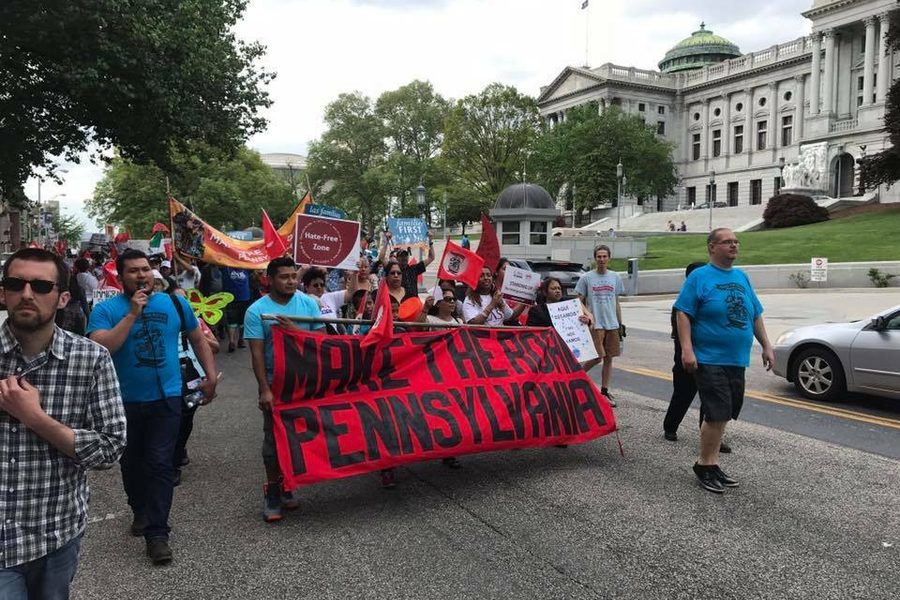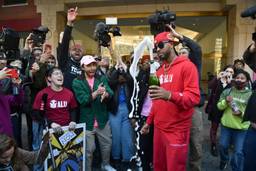What the Big May Day Strike in a Small Pennsylvania City Teaches Us About Organizing
Shaun Richman

The first May Day of the Trump era saw scores of major actions in cities across the United States, but perhaps the most impressive demonstration of worker power took place in the small city of Reading, Pennsylvania. There, 127 stores — about three-quarters of the businesses in the city—shut down in protest, and an additional 500 mostly agricultural and construction workers participated in the general strike, according to organizers. The protest even spread to nearby Allentown, where two dozen more stores closed for the day.
Spearheaded by Make the Road Pennsylvania, a community group that organizes working-class Latinos, the strike was a protest of the county sheriff’s plan to authorize his deputies to act as immigration agents, in cooperation with the Trump administration’s assault on immigrants. While Berks County is one of the economically depressed areas that carried Trump to a win in Pennsylvania, the people of Reading are as unlikely to support his vision for “making America great again” as they are to agree that “America is already great.”
Although the majority of Reading’s residents are Latino, and another significant percentage of the population is African-American, Reading’s mayor and city council are almost entirely white, thanks to a combination of gerrymandering and the political donor class. That’s where the idea of hitting decision-makers in the wallet developed.
“No sales means no sales tax,” says Make the Road Pennsylvania director Adanjesus Marin. “Most of their revenue comes from the communities they’re attacking.”
According to Marin, organizers spent four weeks getting workers and businesses to commit to the May Day strike. Stores that agreed to participate had signs in their windows and flyers near their registers to make visible the growing movement. Many of Make the Road’s activists come from Central America, he says, and have experience in their home countries’ labor movements, so the idea of a May Day action was quickly embraced.
Although the international day of workers’ celebration and protest on the first of May originated in Chicago in the 19th century, for generations since the Cold War, Americans were more likely to associate the holiday with Soviet military parades than with workers’ rights. What May Day events did get organized were often small rallies for dozens of faithful dissidents.
Then, in 2006, May Day came roaring back with the first major “Day Without Immigrants” strike. More than a million immigrant workers and allies struck and staged major rallies to protest the last Republican president’s “get tough” posturing. May Day has been a day of activism and protest — sometimes larger, sometimes smaller — ever since.
As important as reviving International Workers’ Day is in the United States, the actions of Reading’s shopkeepers contribute to something even more essential: reviving the strike. Major work stoppages, those involving 1,000 or more workers, have declined by approximately 90 percent over the past four decades, according to the federal Bureau of Labor Statistics.
That period has been marked by a sustained anti-union offensive by employers. Beginning with the Phelps-Dodge strike in 1983, companies dusted off an obscure Supreme Court precedent that gutted the legal right to strike by taking away workers’ right to return to the job when the strike is over. Companies hard-bargained over pay freezes and benefit reductions, dared their unions to go out on strike and hired scabs to take the strikers’ jobs and vote the union out.
As a result, strikes today are seen by union leaders and members alike as very risky propositions, and job actions have declined accordingly. That is a problem that compounds itself. Our greatest power is still the work we do and our occasional refusal to do it. But if workers don’t see examples of other workers going on strike, what is going to get them thinking about their power and how to exercise it?
What are particularly needed are examples of work stoppages that don’t look like traditional union strikes. The majority of American workers want to be in a union, but our rigged system makes winning a legally certified bargaining unit damn near impossible. If the 90 percent or so of workers who don’t have a union are to protest to demand a better life, a strike is not going to look like bargaining to impasse, printing up picket signs and marching in a long line or a protest pen in front of a factory. But it could look like Reading’s May Day general strike.
Most of the businesses that closed — lunch counters, small grocery stores, cleaners — were single proprietorships or family businesses employing less than five people. “They don’t do better than workers who sell their labor in a traditional way,” says Make the Road’s Marin. Our nation’s labor laws don’t even treat most of them as employees who have rights; many are treated as employers under the law. But they are workers and their strike is an example of a bigger, broader labor movement that fights for more than just wages, hours and working conditions. A labor movement that stands up for the whole community, with the whole community, can inspire more workers to weigh and wield their power. Let Reading be an example.
Shaun Richman is a labor expert at SUNY Empire State University and author of Tell The Bosses We’re Coming: A New Action Plan for Workers in the 21st Century.








